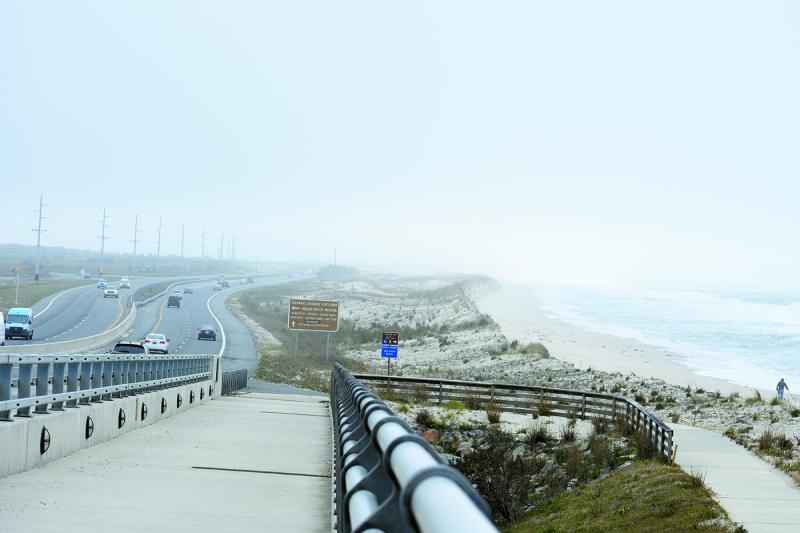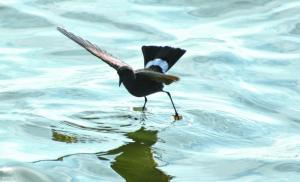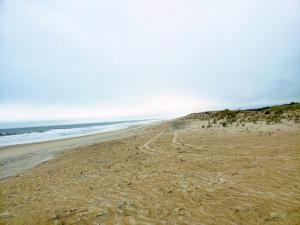Chasing fish after the storm
We just got out of a seven-day nor’easter we dubbed the “bor’easter.” I spent many days just storm chasing and watching 15-foot-plus waves hammer the inlet, with some surfers in the mix on occasion. Fishing was nearly impossible, but we tried. This is striped bass weather, and the northern spring migration is occurring. The real excitement was after the storm eased up and we could cast. Bluefish, big gator bluefish, striped bass and black drum are still hitting. The big blues are a bonus. The question everyone’s asking – Is this like the blitzes that started five years, ago or is this just the usual spring few-day coastal visit amplified by the storm? These fish were blown in and are all over the Inland Bays, too.
We will see in about a week or less if this is a coastal run or just the typical spring visit we usually see. Spoons, poppers and anything shiny are catching bluefish. Mullet is the preferred bait. Bluefish regulations are now three fish per angler.
Anglers can target the smaller fish in the surf now as well. Top and bottom rigs with Fishbites or sand fleas are working fine. The rearranged beaches will take a little time to settle down for the fish. Barney caught an oyster cracker in the surf the other day. That little guy was lost.
Flounder are hitting in the surf, and around the Inland Bays and canals. Anglers fishing for bluefish at the Cape Henlopen pier are picking up flounder on spoons near the beach. The flatties are lying in the small holes around the cape flats, now known as head boat beach because it gets packed for these bluefish.
Sea bass just started, and many boats went out for opening day and did pretty well. Quality fish filling coolers.
The beaches were not destroyed by the nor’easter. If you ask any surf angler or surfer, they will tell you the beaches look wonderful now. The structure in the sand bar system is perfect for surf fishing and surfing. I know the towns are upset due to high tide issues they will deal with, but come winter, they can replenish.
The nor’easter as usual carved up the beaches and moved all the sand off the beach into the sand bar system. That is why the beaches look like New Jersey or Assateague. We get excited to see this but in the dead of winter, meh, we can’t catch. Now this occurs during the spring run and into summer fish arrivals.
We have outer sand bars and troughs. There is an inner sand bar and trough on a few beaches. Large tide pools that are a hundred-plus-feet long drain into the sand bar system where the large cuts form. The wide surf wash is nothing but constant moving structure. Be careful wading these troughs; some are deep and full of quicksand.
Because no one is allowed to move around sand, except at the Indian River Inlet northside sand relocation project to protect the bridge, surf-fishing structure will form up naturally into the summer. This is the best thing a surf angler could ever want – real surf-fishing structure that will hold fish and life in the summer. The park beaches will rebuild naturally; they are never replenished. But this time, the entire coastline is rebuilding naturally.
The park beaches are in fine shape, washed flat into the sand bar zone. The town beaches are eroded messes of cliffs due to man-made dunes. It isn’t the man-made dune system that is the problem, it is the static location. Town dune lines can’t move or “walk.” Same with the dune line at the Indian River Inlet; it is static for protection. These dunes serve a purpose and are rebuilt. Surf anglers don’t like replenishment; it buries the structure on surrounding beaches.
Delaware’s dune system moves back and forth with sea water levels. Storms literally set that line, and the line rebuilds with wind and wave action.
Superstorm Sandy pushed that line onto Route 1 at the base of the Indian River Inlet bridge. That entire area is a barrier island that is supposed to move.
Building a town or structures on top of and against the dune line destroys the natural way dunes work. The east winds can’t move sand to rebuild the beach and dune system by picking up sand and pushing it back onto the beach. Instead, the large sand piles built are eroded away and are only for protection. Or in the case of the houses in Hatteras, they can’t move when the ocean moves. So the house falls into the sea.
Surf fishing this year and right now is going to be a lot of fun with new structure. Get out and surf fish. Every storm from here on out will rearrange the structure. Eventually the beach will settle into a normal structure pattern that we haven’t seen in a long time. Without replenishment there isn’t a lot of “dead” sand to wash into the live sand areas.
All of the Delaware beach towns have already been approved for winter beach replenishment. Sorry, I can’t call it beach nourishment as it has been dubbed. Killing off a food chain is not nourishment to me, but I get the necessity.
Enjoy this surf-fishing structure while it lasts. Take as much advantage as you can; I have been. Fish the drains of the big tide pools. Fish the pools too at low tide, the deep ones. Fish will come in with waves, move into the pools, and then swim to the drain in the current to get out while hunting or being hunted.
Remember where these pools and drains are located, because at high tide that is the hole and cut you want to fish. Walk out to an outer sand bar on the sides of the pools, but watch the soft sand. Wading through a trough can be tough. The outer waves are harder to cast to from the front now.
Have fun out there; the beaches will keep shifting and changing. Do some exploring!
























































